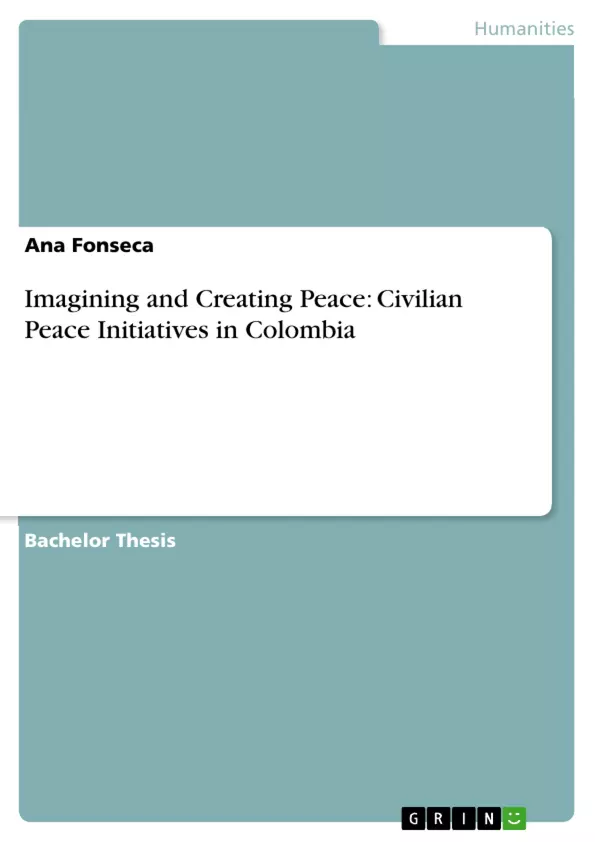Within the broader context of the history of peace talks and social movements in Colombia, this research paper examines civilian peace initiatives that have contributed to the social reintegration of ex-combatant children through the Colombian peace project “Imaginación.” Specifically, this research aims to seek an understanding of some of the socio-cultural, historical, economic and political factors influencing civilian peace initiatives using non-violent means to deal with conflict in Colombia. It also aims to understand the role that anthropology can play in suggesting alternatives to war and violence.
Inhaltsverzeichnis (Table of Contents)
- 1. INTRODUCTION
- 1.1 Aims and Social Significance
- 1.2 Research Questions
- 1.3 Theoretical Concepts
- 1.4 Paper Organization
- 2. METHODOLOGY
- 2.1 Ethics
- 3. LITERATURE REVIEW
- 3.1 A Brief History of the Peace Talks in Colombia
- 3.2 Social Movements in Colombia: is it true that Colombians will not be able to break out with the vicious circle of violence?
- 3.3 A Polarized Country and the “Participant Observer” with a Broken heart
- 4. ANALYSIS
- 4.1 Peace Project Imaginación: “Peace is in the hands of everyone”
- 4.2 Activating the Anthropological Imagination
- 5. CONCLUSION
- 5.1 Some Challenges and Suggestions for Further Research
Zielsetzung und Themenschwerpunkte (Objectives and Key Themes)
This research paper explores the significance of civilian peace initiatives in Colombia, specifically focusing on the Peace Project “Imaginación”. It examines the role of such initiatives in promoting peace and non-violent behavior within a society grappling with prolonged conflict. The paper highlights the importance of shifting the anthropological focus from conflict and violence to peace-building efforts. The key themes explored in this paper include:- The social significance of human conflict and the need for peace-building initiatives
- The importance of understanding and supporting civilian peace initiatives in Colombia
- The limitations of traditional anthropological approaches to conflict resolution and the need for a broader focus on peace and non-violence
- The role of the anthropological imagination in promoting peace-building efforts
- The specific challenges and opportunities associated with civilian peace initiatives in Colombia
Zusammenfassung der Kapitel (Chapter Summaries)
This research paper delves into the complex issue of human conflict and peace-building in Colombia. Chapter 1 establishes the research's objectives and social significance, emphasizing the need to understand and support civilian peace initiatives in the country. It outlines the research questions, theoretical concepts, and the organization of the paper. Chapter 2 outlines the methodology used for the research, including ethical considerations. Chapter 3 provides a comprehensive literature review, exploring the history of peace talks in Colombia, examining the dynamics of social movements, and analyzing the country's polarized context. Chapter 4 offers an in-depth analysis of the Peace Project “Imaginación,” highlighting its methods, aims, and impact. It discusses the role of the anthropological imagination in fostering peace-building efforts. Finally, Chapter 5 presents the conclusion and suggests areas for future research.Schlüsselwörter (Keywords)
This research paper examines the multifaceted issue of conflict resolution in Colombia. Key terms and themes include civilian peace initiatives, anthropological perspectives on conflict, the role of the imagination in peace-building, social movements, and the impact of violence on Colombian society. The paper also explores the importance of shifting the focus from conflict and violence to peace-building efforts, highlighting the need for greater understanding and support of initiatives like the Peace Project “Imaginación.”
Excerpt out of 59 pages
- scroll top
- Quote paper
- Ana Fonseca (Author), 2008, Imagining and Creating Peace: Civilian Peace Initiatives in Colombia, Munich, GRIN Verlag, https://www.grin.com/document/280017
Look inside the ebook



